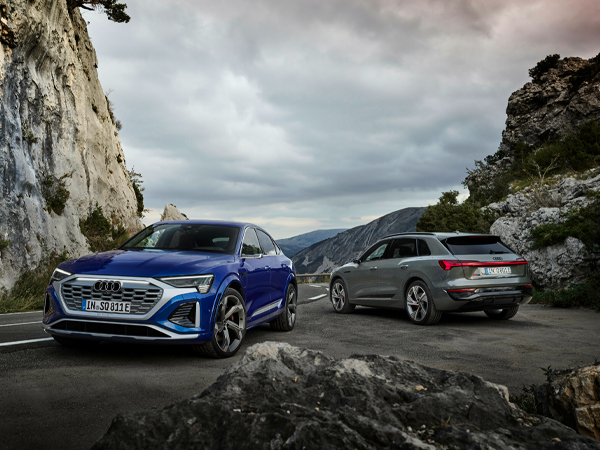
The new Audi Q8 e-tron
“The icon has been reborn. At Audi, the e-tron is a symbol of electromobility, as it was with this model that the brand embarked on its path of transformation in 2018. Now, the new Q8 e-tron has arrived to continue the success story of the first model, and we are contributing to that success by making the motors at our Győr factory. Our e-motor factory is clear evidence of the transformation in powertrain production taking place at our Győr site,” explains Robert Buttenhauser, board member responsible for powertrain production at Audi Hungaria.
In the four years that passed between the debut of the first model and the world premieres of the new Q8 e-tron and Q8 Sportback e-tron in November 2022, eight models have been added to the brand’s electric portfolio, and Audi has sold more than 150,000 electric vehicles. By 2026, there will be more than 20 electric Audi models on the market.
The Q8 e-tron and Q8 Sportback e-tron, manufactured at the brand’s Brussels site, are premium electric SUV and crossover models. They offer a new optimised drive concept, improved aerodynamics, enhanced charging performance and increased battery capacity, along with the impressive range that this brings. The SUV version can travel up to 582 kilometres on a single charge, while the Sportback can reach up to 600 kilometres.
Powertrains from Győr
Both body styles are available with a choice of three types of all-wheel-drive electric powertrains. The two motors in the basic models, the Audi Q8 50 e-tron and Q8 50 Sportback e-tron, deliver 250 kW of total power in boost mode with a maximum torque of 664 Nm, while the Audi Q8 55 e-tron and Q8 55 Sportback e-tron have a drive system capable of generating a total of 300 kW of power. The top-of-the-range Audi SQ8 e-tron and SQ8 Sportback e-tron models are now powered by three motors that deliver 370 kW of power and 973 Nm of torque in boost mode.
The electric powertrains are based on an optimised drive concept and manufactured by Audi Hungaria staff in Győr. The Győr factory is the largest producer of engines in the world. Since the introduction of the Audi e-tron in 2018, we have been progressing on the path towards electromobility, providing significant support for Audi’s electric strategy. In this time, our company has made more than 350,000 electric power sources, aided by targeted training courses for our colleagues to learn the expertise and competencies necessary for the transition. With the Audi Q8 e-tron electric motors, electric powertrains make up an increasing share of our production, and our company is already preparing to produce the next generation of electric motors.
The roads we’re taking are green
With its comprehensive approach to ESG, Audi Hungaria is committed to creating a more liveable environment, fully in line with AUDI AG’s Mission:Zero strategy. The goal is for all Audi sites to become CO2 neutral in their operations by 2025. Brussels and Győr have already achieved this objective, and the rail transport between the two locations – as well as to the Ingolstadt site – is also carbon neutral. This green chain also includes the new Q8 e-tron and its Győr-produced powertrains.
At Audi Hungaria, sustainability is more than just a nice-sounding promise – it is one of the founding pillars of a shared approach that points us towards a greener future. In 2018, these efforts saw the group’s Brussels site become the first to go fully carbon neutral with the start of production for Audi’s first all-electric model, the Audi e-tron – earning it the title of “the first certified carbon neutral, large-scale production facility in the premium segment.”
The Győr site soon followed Brussels in the transition to sustainable manufacturing. Since 1 January 2020, our balance sheet has been proudly carbon neutral. Our decarbonisation effort – and the outcome – rests on three main pillars. The first is an increase in energy efficiency and, as part of this, a switch to green energy. With this in mind, ever since 1 January 2020, 100% of Audi Hungaria’s electricity has come from renewable sources, part of which is generated on the company’s premises by Europe’s largest rooftop solar farm. We see the second pillar as harnessing the energy of the Earth. With a geothermal power plant commissioned in 2012, we generate more than 70% of the thermal energy needed to run the company from renewable sources, making us the largest industrial geothermal energy user in Hungary.
Finally, the third pillar is offsetting carbon emissions. Our company purchases internationally recognised and verified carbon credits to compensate for the operation of areas – such as engine test benches – where CO2 emissions are still unavoidable. Responsible thinking extends not only to the operation of individual sites, however, but also to the logistical movement of goods between them. This is why, since 2019, all Audi Hungaria’s rail transport of materials with DB Cargo has been CO2-neutral, meaning that trains loaded with parts, finished engines, motors and cars are transported on a climate-neutral basis between Győr and Ingolstadt. This is not the only green logistics route, however: the electric motors made at Audi Hungaria – already green in terms of their operation – are also transported sustainably on ‘green trains’, without any environmental impact, to their final destination in Brussels. This includes the electric drivetrain system made in Győr that powers the front and rear axles of the new Q8 e-tron.

Mission:Zero
Audi’s environmental programme spans borders and continents. As part of Mission:Zero, measures have been introduced to reduce the company’s ecological footprint in both production and logistics for every Audi production site – Ingolstadt, Neckarsulm, Brussels, Győr and the Mexican city of San José Chiapa. Our most important challenges are decarbonisation, reducing water usage, improving resource efficiency and the conservation of biodiversity.
